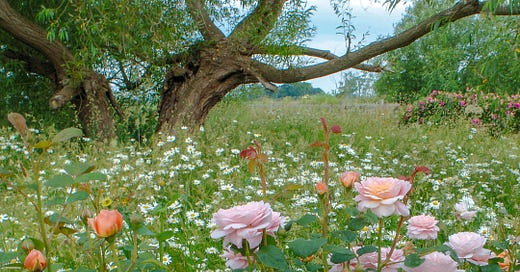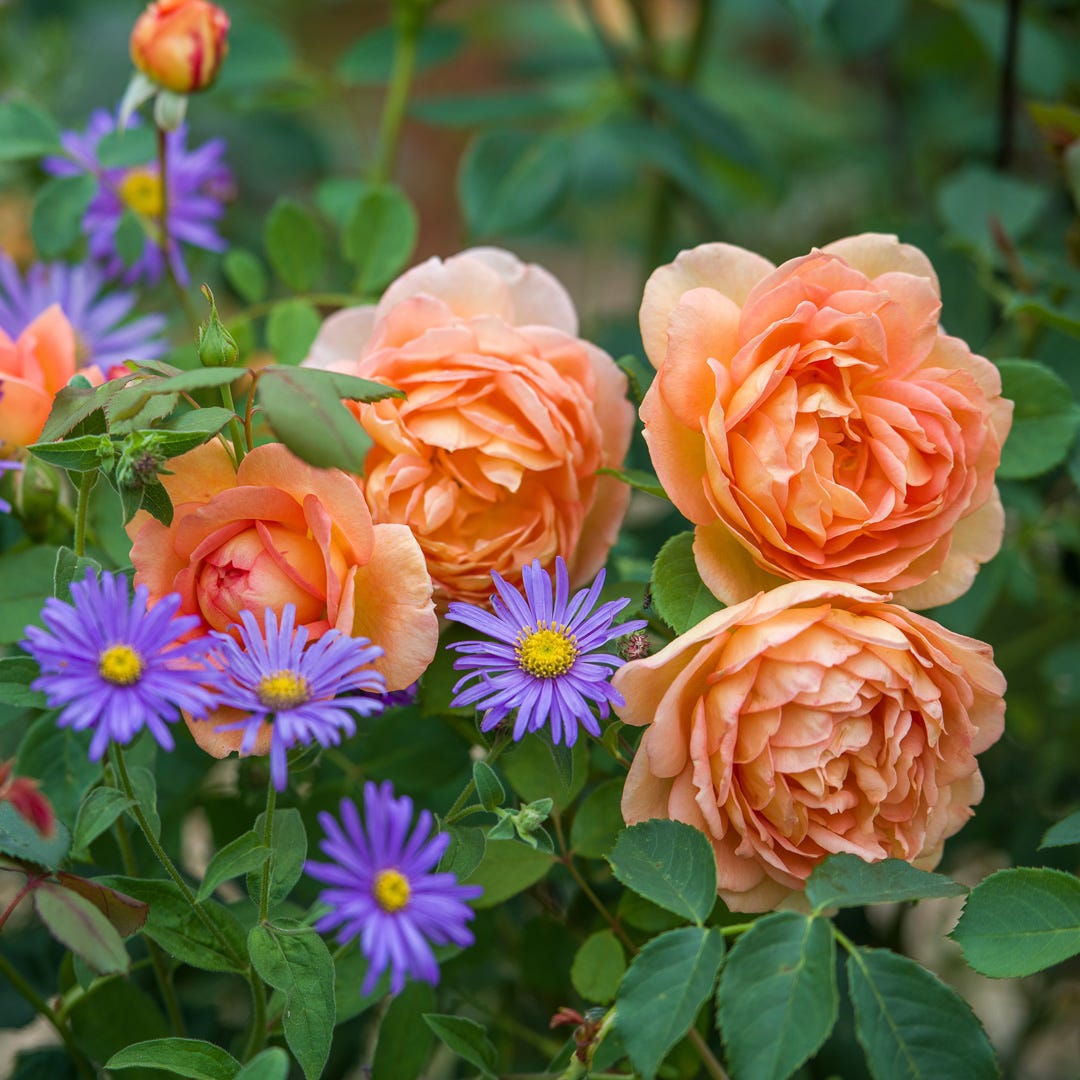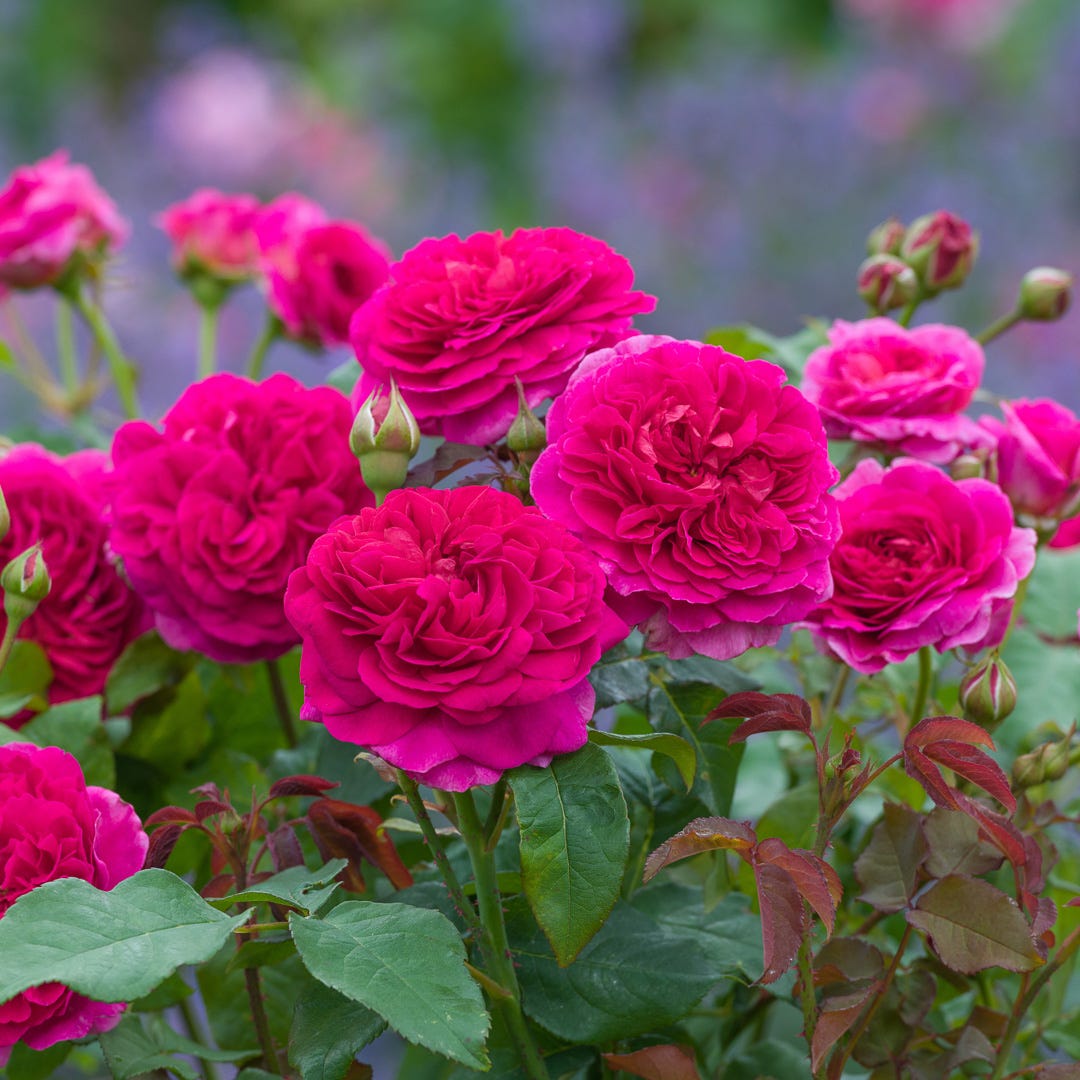Who doesn’t love roses? And who doesn’t love roses that are voluptuous like these below? Their charm is enhanced by seeming to grow with ease in a meadow with ox-eye daisy…read on to hear the real story of these beauties.
These extraordinarily full and shrubby roses have been experiencing a resurgence in the last 50 years or so. I know, that’s a long resurgence, but the reality is that hybrid tea, floribunda and grandiflora roses have been the norm in the rose world forever. That’s fine if you live in Florida or California, but not if you live in more northern climes.
In my father’s time, that is, from the 20s through the 1950s and 60s especially, hybrid tea roses were being bred willy-nilly and as a result, were all the rage to those with gardens and means. These are still the roses that you can buy for your sweetheart on Valentine’s Day and they have many excellent qualities, namely an extended vase life, long stems, beautiful colours and in many cases, strong fragrance. My father’s favourite was ‘Chrysler Imperial’, a velvety red rose that was bred in 1952, three years before he married my mother, and the colourful expression of passionate love.
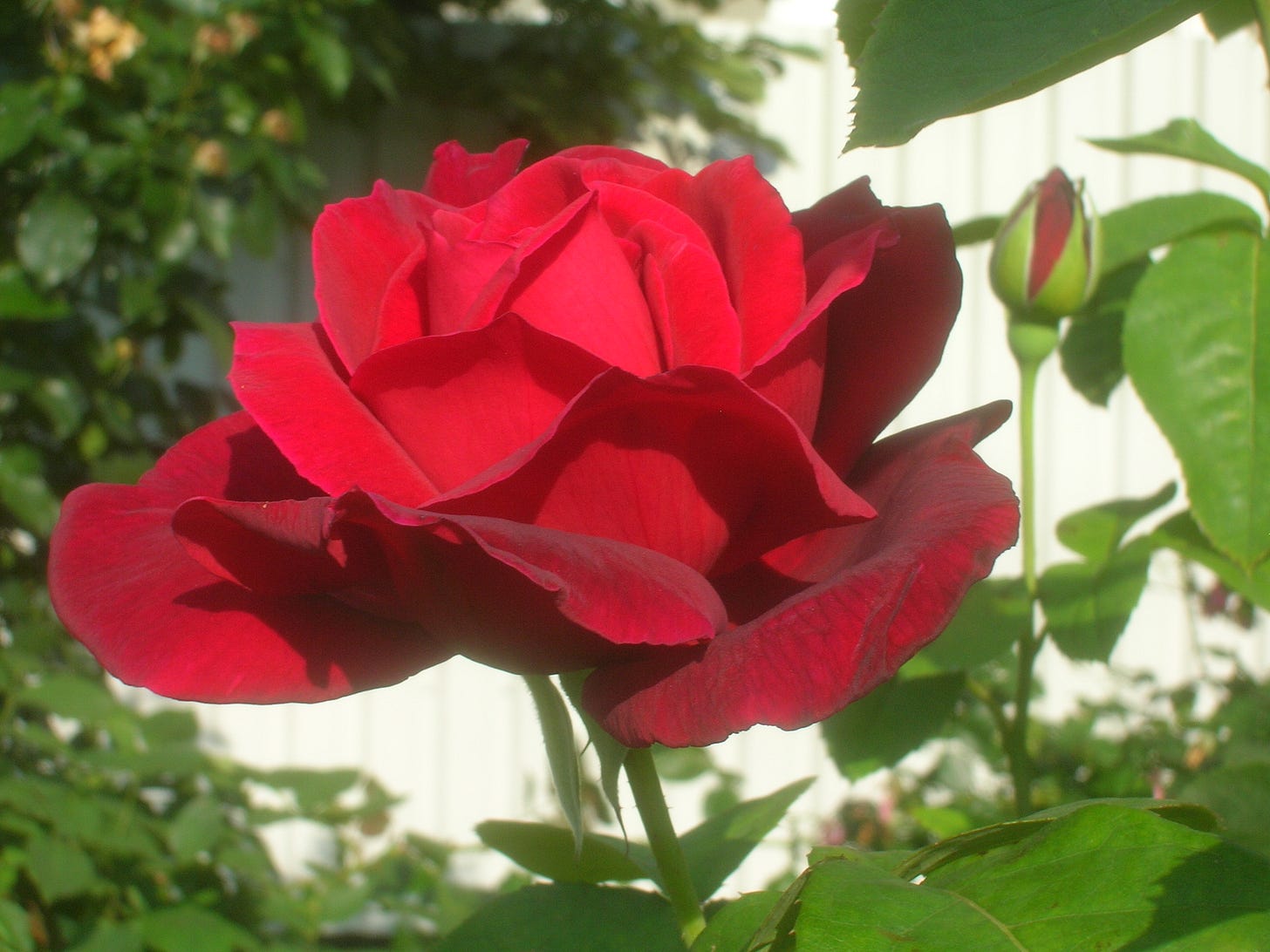
But of course many hybrid tea roses were a tease (insert pun here) in the garden, especially Canadian gardens that were (and still are!) brutally cold in the winter months. And if they didn’t succumb to frigid temperatures, they were riddled with disease, considered candy to pests and never really looked as good in the garden as they did in the vase.
That didn’t seem to discourage many gardeners though, and sales of hybrid tea roses were always strong — people just seemed to treat them as annuals. I still remember visiting the formal rose garden at Ottawa’s Experimental Farm when I was younger and seeing the sad, defoliated sticks that passed as roses on display there. Today, I counted two hybrid teas in the rose bed inventory, with the majority being old garden roses, new Canadian cultivars, rugosas and a smattering of David Austin hybrids.
Enter David Austin. Austin began as an amateur rose breeder living in Shropshire, England, in the 1950s who sought to revive the desirability of old garden roses with the 20th century gardener. He loved the cabbage-like blooms of these old-fashioned types and sought to breed into them the positive qualities of newer roses — qualities like extended blooming or repeat flowering, fragrance, size (both shrub and climbing), and exquisite colour offerings. Many of the Austin roses remind me of the flowers of double hollyhocks, like the tissue paper flowers you’d make as a child — as an aside, get a load of these tissue flowers made by the creative genius Tiffanie Turner here.
Through the help of friend and horticultural legend, Graham Stuart Thomas, Austin was able to get his new hybrid rose ‘Constance Spry’ to the attention of a local nursery and in 1961 it went to market. This cultivar was a cross between Rosa ‘Belle Isis’ (a historic 19th century Gallica or French rose, grown at Malmaison by the Empress Josephine) and Rosa ‘Dainty Maid’ (a floribunda rose bred in 1940). Although it only bloomed once in early summer, it had a distinctive myrrh fragrance and reached dizzying heights of twenty feet! The distinctive scent of myrrh has been described as warm, spicy, bitter, with smoky and musky undertones.
Since its introduction, the Austin name has been attached to almost 200 more roses. There is an amazing array and although most are not hardy for us here in Zone 4-5 (‘Constance Spry’ is hardy to Zone 6, which means it can be grown successfully in southern Ontario and along the lakeshore), there are notable exceptions. Let me show you some of the David Austin roses that are hardy in Zone 4:
This floriferous and large flowered shrub is a great addition to a mixed border as it reaches 5’ high with a breadth of 4’. It is fragrant, with hints of spiced apple and cloves and each flower sports about 60 petals, in shades of salmon to pink to orange to golden yellow. As it is a repeat bloomer, it pairs beautifully with perennials in the blue/purple range like this fall blooming New England aster. Rosa ‘Lady of Shallot’ was bred in 2009 and received the Royal Horticultural Society’s Award of Garden Merit.
Another shrub rose but this time with a bit of a smaller profile (4’ tall by 3’ wide), ‘Eustacia Vye’ has it all: its buds open broadly and then row upon row of ruffled petals unfurl, much like that of the most extravagant peony — ‘Sarah Bernhardt’ comes to mind; it has a strong and fruity fragrance; it is a vigorous plant and is a repeat bloomer throughout the summer to frost; and finally it is known to be resistant to disease. It is one of the newer Austin roses, making its debut at the 2019 Chelsea Flower Show.
A similar size to the preceding roses, ‘Gabriel Oak’ is named after the all-suffering but stalwart romantic character in Thomas Hardy’s Far from the Madding Crowd. It is likewise a dependable rose, with a strong, sweet fragrance and the richness of luscious, dark pink blooms against healthy foliage. It flowers repeatedly from late spring to fall and provides a striking, almost fluorescent, hot colour in the garden.
In contrast to perhaps the profanity of ‘Gabriel Oak’, we find the sacred with the creamy white rose called ‘Winchester Cathedral’. A touch less hardy (pun unintended) than the previous roses (that is, Zone 5), it nevertheless is a strong grower with repeat blooms through the summer. Developed in 1988, it was a white sport of the very popular pink ‘Mary Rose’, perhaps one of the most loved David Austin roses. Like it’s parent, it has a delicious fragrance of honey and almond blossom. It is a good size at 4’ wide and tall, and in this picture is paired beautifully with the delicate yellow blooms of Alchemilla mollis, the perennial known as lady’s mantle.
Unusual for yellow blooming roses, ‘The Poet’s Wife’ is a strong grower with excellent disease resistance. It is also blessed with a distinct lemony fragrance that becomes more pronounced with age. It has an incredible 72 petals in each blossom and is loaded with them from early summer to frost, fading to soft tones as they mature. Bred in 2014, it is a solid performer in any garden and fills a space 4’ square with beauty.
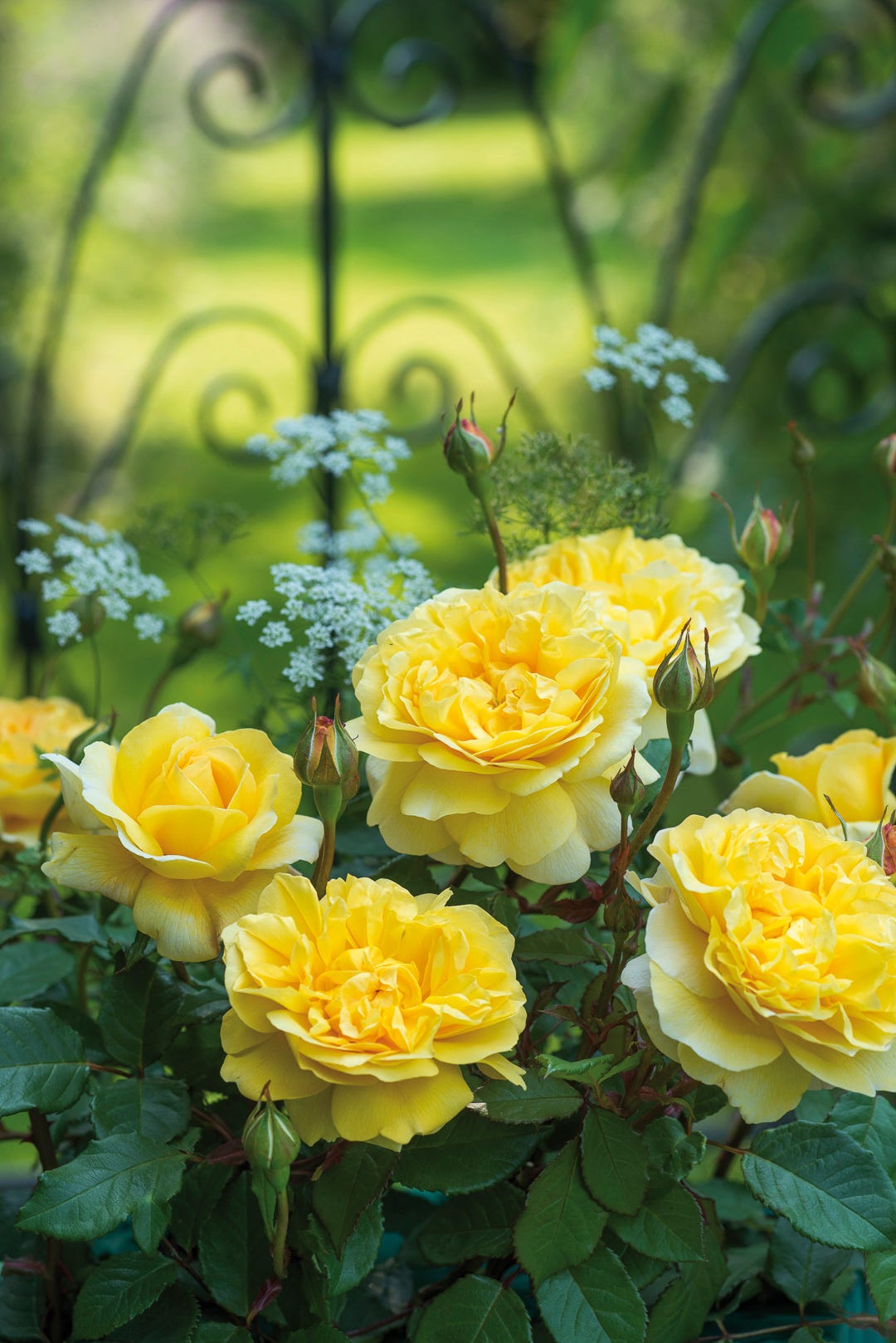
You can normally find a selection of David Austin roses at your local nursery in the spring, moreso when they begin to bloom in their containers — an easy sell when that happens! If you see them at a family run nursery, you’ll likely only be able to choose from those that are hardy — a good thing — but at the big box stores, you may be spoiled for choice! Be careful though as they’ll no doubt have hybrids that are too tender for our climate. If you’re not sure of their hardiness, don’t be seduced by the colourful tags; look on your phone to check or go home and do your research first. Or, scour the internet for mail-order sellers and get your order in now, before they sell out! What better way to spend a winter evening….
